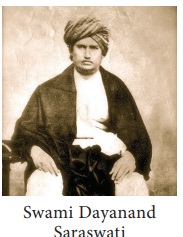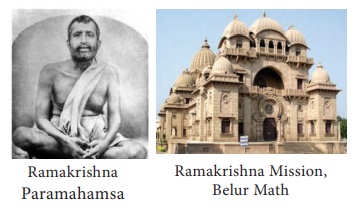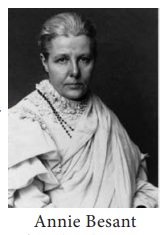Social and Religious Reform Movements in the 19th Century - Hindu Revivalism | 10th Social Science : History : Chapter 5 : Social and Religious Reform Movements in the 19th Century
Chapter: 10th Social Science : History : Chapter 5 : Social and Religious Reform Movements in the 19th Century
Hindu Revivalism
Hindu Revivalism
(a) Swami Dayanand Saraswati and Arya Samaj 1875
In the
Punjab, the reform movement was spearheaded by the Arya Samaj. It was founded
(1875) by a wandering ascetic in the western Gangetic plain, Swami Dayanand
Saraswati (1824–83).

Swami Dayanand
later settled in the Punjab to preach his ideas. His book, Satyarthaprakash, enjoyed wide circulation. He declared the
practices such as child marriage, the prohibition of widow remarriage, and the
alleged polluting effects of foreign travel had no scriptural sanction. The
positive principles enunciated by Dayanand were: strict monotheism,
condemnation of idolatry, and rejection of Brahman domination of ritual and
social practices. He also rejected superstitious beliefs in Hinduism and his
cry was “go back to Vedas.”
Arya
Samaj attempted to check the incidence of religious conversion in British
India. One of its main objectives was counter-conversion, prescribing a
purificatory ceremony called suddhi, directed at Hindus who had converted to
Islam and Christianity.
The
primary achievements of the Arya Samaj were in the field of social reform and
spread of education. The Samaj started a number of Dayananda Anglo–Vedic
schools and colleges.
(b) Ramakrishna Paramahamsa
Ramakrishna
(l836–86), a simple priest of Dakshineswar near Kolkata, emphasised the
spiritual union with god through ecstatic practices such as singing bhajans. An
ardent worshipper of goddess Kali, the sacred mother, he declared that the
manifestations of the divine mother were infinite. In his view, all religions
contain the universal elements which, if practised, would lead to salvation. He
said, “Jiva is Siva” (all living beings are God). Service for man, must be
regarded as God.’

Ramakrishna Mission
Ramakrishna’s
primary achievement was his ability to attract educated youth who were
dissatisfied with the rational orientation of religious reform organizations
such as the Brahmo Samaj. After his death in 1886, his disciples organised themselves
as a religious community and undertook the task of making his life and teaching
known in India and abroad. The chief spirit behind this task was Vivekananda.
Following the organizational structure of Christian missionaries, Vivekananda
established the Ramakrishna Mission which did not restrict itself to religious
activities but was actively involved in social causes such as education, health
care and relief in times of calamities.
(c) Swami Vivekananda
Narendra Nath Datta (l863–1902), later known as
Swami Vivekananda, was the prime follower of Ramakrishna Paramahamsa. An
educated youth, he was drawn to Ramakrishna’s message. Dissatisfied with
conventional Swami philosophical positions Vivekananada and practices, he
advocated the practical Vedanta of service to humanity and attacked the
tendency to defend every institution simply because it was connected with
religion. He emphasized a cultural nationalism and made a call to Indian youth
to regenerate Hindu society. His ideas bred a sense of self-confidence among
Indians who felt inferior in relation to the materialist achievements of the
West. He became famous for his addresses on Hinduism at the 1893 World Congress
of Religions in Chicago. Despite his fame, he was condemned by orthodox Hindus
for suggesting that the lower castes should be allowed to engage in the Hindu
rituals from which they were traditionally excluded. Vivekananda’s activist
ideology rekindled the desire for political change among many western-education
young Bengalis. Many of the youths who were involved in the militant
nationalist struggle during the Swadeshi movement following the Partition of
Bengal were inspired by Vivekananda.

(d) Theosophical Movement
The
Theosophical Society was founded by Madame H.P. Blavatsky (1831–1891) and
Colonel H.S Olcott (1832–1907) . Founded in the USA in 1875, it later shifted
to India at Adyar, Chennai in 1886.
Theosophical
Society stimulated a study of the Hindu classics, especially the Upanishads and
the Bhagavad Gita. The Theosophical Society also played an important role in
the revival of Buddhism in India. Western interest in Hindu scriptures gave
educated Hindus great pride in their tradition and culture.
Contribution of Annie Besant
In India
the movement became further popular with the election of Annie Besant
(1847–1933) as its president after the death of Olcott. She played a role in
Indian nationalist politics, and formed the Home Rule League demanding home
Annie Besant rule to India on the lines of Ireland. Annie Besant spread
Theosophical ideas through her newspapers called New India and Commonweal.

Related Topics